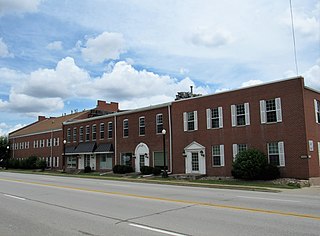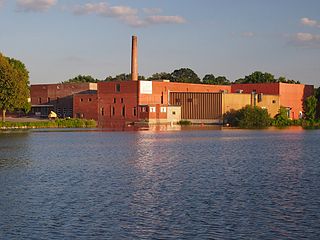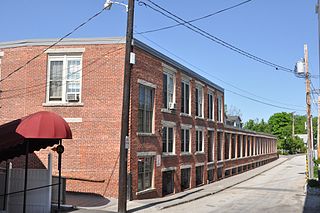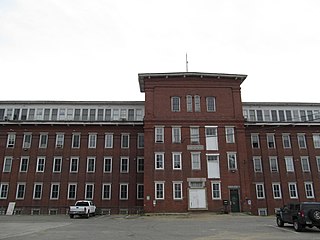
Rockingham County is a county located in the U.S. state of North Carolina. As of the 2020 census, the population was 91,096. Its county seat is Wentworth. The county is known as "North Carolina's North Star".

Eden is a city in Rockingham County in the U.S. state of North Carolina and is part of the Greensboro-High Point Metropolitan Statistical Area of the Piedmont Triad region. As of the 2020 census, the population was 15,405. From the late nineteenth century through much of the 20th, the city was a center of textile mills and manufacturing. The city was incorporated in 1967 through the consolidation of three towns: Leaksville, Spray, and Draper.

The Wilcox, Crittenden Mill, also known as Wilcox, Crittenden Mill Historic District, is a 17-acre (6.9 ha) property in Middletown, Connecticut that was listed on the National Register of Historic Places in 1986. It was the location of the Wilcox, Crittenden company, a marine hardware firm. The historic district listing included four contributing buildings and three other contributing sites.

Mill Conversion or mill rehab is a form of adaptive reuse in which a historic mill or industrial factory building is restored or rehabilitated into another use, such as residential housing, retail shops, office, or a mix of these non-industrial elements (mixed-use).

The Whittenton Mills Complex is a historic textile mill site located on Whittenton Street in Taunton, Massachusetts, on the banks of the Mill River. The site has been used for industrial purposes since 1670, when James Leonard built an iron forge on the west bank of the river. The first textile mill was built in 1805 and expanded throughout the 19th century. The complex was added to the National Register of Historic Places in 1984, and now contains various small businesses.

The North Canal Historic District of Lawrence, Massachusetts, encompasses the historic industrial heart of the city. It is centered on the North Canal and the Great Stone Dam, which provided the waterpower for its many mill complexes. The canal was listed on the National Register of Historic Places in 1975, while the district was first listed in 1984, and then expanded slightly in 2009.

The Hamilton Woolen Company Historic District encompasses the well preserved "Big Mill" complex of the Hamilton Woolen Company, built in the mid 19th century. Located at the confluence of McKinstry Brook and the Quinebaug River in central Southbridge, Massachusetts, the complex consists of a cluster of mill buildings and a rare collection of 1830s brick mill worker housing units located nearby. The district was listed on the National Register of Historic Places in 1989.
Stuyvesant Falls Mill District is a national historic district located in the town of Stuyvesant in Columbia County, New York. The district includes six contributing buildings, five contributing sites, and two contributing structures. They are the industrial sites and power sources from which the adjoining hamlet of Stuyvesant Falls derived its livelihood. It includes the Upper and Lower Falls and mill dams; on the east bank of Kinderhook Creek the sites of a grist mill and paper mill, cotton mill, woolen mill complex and extant hydroelectric plant; west bank operations including three extant 19th century cotton mills and several dwellings. Also included is an iron truss bridge erected in 1899.

Shields Woolen Mill is located along the edge of the Mississippi River in Davenport, Iowa, United States. It has been listed on the National Register of Historic Places since 1983. The building has been repurposed as commercial and office space called One River Place.

The Faribault Woolen Mill Company is a textile manufacturing company in Faribault, Minnesota, United States, that produces and sells wool blankets and other woolen products. Its products included ingeo, cotton, acrylic and wool bed blankets, pillows, mattresses, pads, and baby blankets, and wool, ingeo and blend throws. The company sells its products through its store in Faribault and nationwide through retailers.

Mississippi Mills was a cotton and wool textile manufacturing complex that operated in Wesson, Mississippi, during the latter half of the 19th century. By 1892, Mississippi Mills was described as the largest industry of its kind in the South.

The Winooski Falls Mill District is located along the Winooski River in the cities of Winooski and Burlington, Vermont, in the United States of America. It encompasses a major industrial area that developed around two sets of falls on the river in the 19th century.

Washington Avenue Historic District, or Washington Avenue Factory District, is a national historic district located in the Hawthorne and Bella Vista neighborhoods of South Philadelphia, Pennsylvania. It comprises the remaining four blocks of one of the last industrial neighborhoods in Philadelphia, and encompasses eight contributing buildings built between 1889 and 1927:

The Hilgen and Wittenberg Woolen Mill is a former textile factory in Cedarburg, Wisconsin. Built in 1864, the mill was one of many wool- and flax-processing factories that opened during the American Civil War, due to a shortage of cotton textiles formerly supplied by southern states. The mill produced yarns, blankets, and flannels, and was the largest woolen mill west of Philadelphia in the 19th century. The mill closed in 1968 and has since become a commercial complex called the "Cedar Creek Settlement," containing restaurants and stores.

The Contoocook Mills Industrial District of Hillsborough, New Hampshire, encompasses the industrial mill complex of the Contoocook Mills, a major business in the town from the 19th century to the mid-20th century. Industry on the banks of the Contoocook River in Hillsborough began as early as 1763, when a sawmill and gristmill were operated in the area. More modern industrial activity began in 1828 with the construction of a cotton mill by Josiah Marcy. This three story timber frame building stands on the south side of Mill Street, on a granite foundation through which a raceway provide the water which powered the mill. Marcy expanded his operations, building a grist mill and saw mill before his death in 1848. The grist mill, a handsome brick building on the north side of Mill Street, was operated as such until 1884, after which it was converted into the picker building for the main mill complex.

The Milford Cotton and Woolen Manufacturing Company is a historic mill complex at 2 Bridge Street in the center of Milford, New Hampshire. Developed between 1813 and World War I, it is one of the few surviving mill complexes in Milford, whose name is derived in part from "mill". The buildings were listed on the National Register of Historic Places in 1982. The complex has been converted into residential use.

The Salmon Falls Mill Historic District encompasses a historic mill complex on Front Street in Rollinsford, New Hampshire. The complex includes four major structures and seven smaller ones, on about 14 acres (5.7 ha) of land along the Salmon Falls River. They were built between about 1840 and the mid-1860s, and have an unusual architectural unity, for additions made to the buildings were done with attention to matching design elements from the existing structures. The Number 2 Mill, built in 1848, was an early location where a turbine was used instead of a waterwheel to provide power to the mill machinery. The district was listed on the National Register of Historic Places in 1980.

Riverside Industrial Historic District, also known as Asheville Wholesale District, is a national historic district located at Asheville, Buncombe County, North Carolina. The district encompasses 27 contributing buildings and 1 contributing structure in a predominantly industrial section of Asheville. Notable buildings include the Orpheus and Bertha Keener House, American Feed Milling Company, Italianate style Carolina Coal & Ice Company, Asheville Cotton Mill Cloth Warehouse, Standard Oil Company complex, and Farmers Federation Building.

The Winthrop Mills Company is a historic textile mill complex at 149-151 Main Street in Winthrop, Maine. Developed mainly between the late 19th and mid-20th centuries, it was the nation's largest manufacturer of woolen blankets for many years, and a major local employer for about 150 years. It was listed on the National Register of Historic Places in 2014.

The Winsted Hosiery Mill, also known as the Whiting Mill, is an industrial complex at 210 Holabird Avenue in the Winsted section of Winchester, Connecticut. Developed in the late 19th and early 20th centuries, it was one of the largest industrial employers in the community for many years, and is relatively unaltered from its period of development. It was listed on the National Register of Historic Places in 1985. It is now subdivided for multiple industrial and commercial tenants.



























